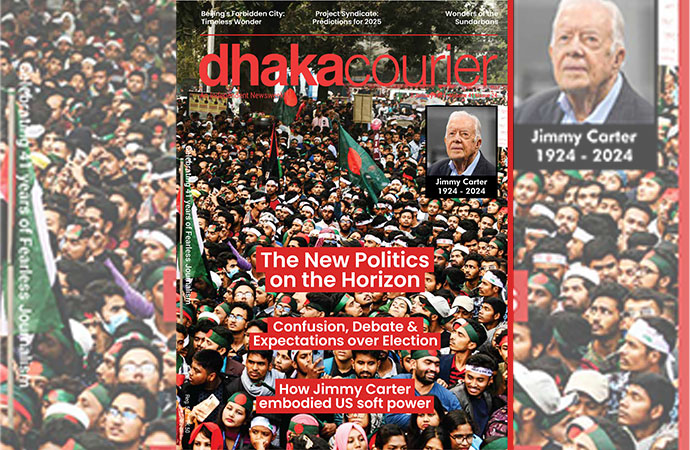Business

After a summit with China in December, Saudi Arabia suggested it would be happy to sell its oil in a currency other than dollars. Photo: Xinhua/UNB
Financial shocks in recent years are forcing the global monetary architecture to change, say some economists
Two small but critically important pieces of news in the past few weeks are early indicators that the global economic order, centred on the primacy of the dollar, is slowly coming apart - bringing the threat of radically worsened instability.
First, Saudi Arabia's finance minister said the Gulf kingdom had "no objection" to selling its oil in a currency other than dollars. Saudi has made similar noises before, but this latest suggestion comes after Chinese president Xi Jinping urged Gulf countries to take up the yuan for the settlement of oil and gas trades with China at the first China-Arab States Summit, hosted with great pomp and ceremony by Saudi's Crown Prince Mohammed Bin Salman in Riyadh last month.
As the world's largest crude oil exporter, and (until recently) a lynchpin of US strategy in the Middle East, any such moves by Saudi Arabia would be big news. It would mean the world's first and second largest oil exporters - Saudi and Russia - would no longer be looking to trade that oil solely in dollars.
In recent years, Saudi has been developing increasingly close ties with China, the world's largest oil importer. The December summit saw both sides repeat their "firm support" for each other and sign a series of deals on trade and technology. These included a memorandum of understanding with Chinese tech giant Huawei on supplying cloud computing and high-tech infrastructure for Saudi cities, in defiance of US bans. A new 'petroyuan' would cement this rupture in the international system.
On the other side of the world, there was the announcement by Brazil and Argentina that they, too, would be looking to use a new currency for bilateral trade - this time establishing an entirely new money, potentially to be called the 'sur'. There have been moves to create joint Brazil-Argentine currencies before, but they have tended to flounder on political grounds, with strong opposition from both countries' central banks.
Now, with left-leaning and independent-minded governments in both countries, there is a greater willingness to try and establish a new currency, separated from the dollar system. Early reports indicate that it is planned to be a foreign-trade only instrument, used in settling payments for cross-border trades rather than something you'd take to the shops. Both countries recognise the complications involved, but with other South American countries invited to join it could, over time, start to function as an alternative to the dollar.
Put these two items together and they feed into a general pattern where major economies are starting to back out of the dollar-dominated global system. Since the end of the Cold War, we have all lived in a world where the US economy, and with it the dollar, are overwhelmingly important.
The system has wobbled on occasion, perhaps most dramatically in the 2008 global financial crisis. But historian Adam Tooze's account of that crisis, 'Crashed', argues that the crisis demonstrated the power of the US, which was eventually able to stabilise the rest of the global economy via a system of 'swaplines' from the Federal Reserve. These offered very cheap dollars in an emergency to politically favoured countries like Britain, granting them a bailout of domestic financial institutions.
This gave the US huge weight - if you can choose to rescue someone, or not, you have immense power over them, as Tooze argues. Even the threat of removing emergency support can give you power. But it was that demonstration of power that helped sow the seeds for the system's steady collapse, as we are seeing today.
Precisely because the US was able to exercise its monetary power in a way that matched its broader interests - so only its closest allies had access to swaplines, but every country could find itself in need of dollars, in an emergency - it has created incentives for other countries to withdraw, as far as is possible, from the dollar-centred international monetary system.
End of the dollar regime
Since 2008, other economies, led by China, have grown faster than the US, and some close US allies, like Britain, have fallen behind. Covid also dramatically jolted the whole system, and we're still very much living with the virus and its consequences - in terms of health, disrupted supply chains, and the very substantial amounts of debt that lockdowns generated.
When the US unambiguously dominated the globe, as it did in the years after the end of the Cold War, being simultaneously the largest economy, the technological leader, and the greatest military power on the planet, there was little room or sense in making such a withdrawal. But as US power has waned in those different dimensions, the risks of a withdrawal from the system have also lessened for countries contemplating it.
On the other hand, the risks of remaining inside the dollar system - particularly if you are outside the US's charmed circle of close allies - have also been raised dramatically higher by Russia's invasion of Ukraine, and the subsequent imposition of sanctions on Russia. When the tanks rolled over the border almost a year ago, the reaction from the US and its allies was swift: Russia's unimpeded access to the dollar payments system was unceremoniously blocked, just as Iran, earlier in the last decade had found itself barred.
This sudden restriction acted as a giant warning sign to every other country relying on the global dollar payments system, says Zoltan Poszar, the head of global strategy at Swiss bank Credit Suisse. If Russia could be excluded on the say-so of the US government, so could any country. Poszar thinks that in addition to the opportunity to withdraw from the system, created by the relative decline of the US compared to other great powers, the Russian invasion of Ukraine created the incentive to withdraw, so as to avoid a country potentially finding itself, in the future, exposed to the whims of Washington.
Poszar thinks that a new, multipolar international currency system is emerging, which he has labelled 'Bretton Woods III', referencing the idea that, since the end of the Second World War, the world has passed through three different international monetary systems. The first was designed at the Bretton Woods conference in the US in 1944, where the Allied powers tried to lay down the ground rules for how the post-war international monetary system would work. This agreement set up the World Bank and the International Monetary Fund, which are still with us, and a system of fixed currency exchange rates, pegged to the dollar (and then to gold), which is not: the system collapsed in the early 1970s when the US refused to maintain the dollar's fixed price in gold any longer.
The second 'Bretton Woods' appeared some 20 years later, as the new global financial system stabilised in the wake of the Cold War's end. The US acted as a huge, debt-funded consumer, exploiting global demand for the dollar in trade and as a reserve to run up huge debts against the rest of the world. Other nations were happy to lend to the US - both its government and its households and businesses - because those in the US, in turn, were happy to buy from fast-growing economies like China. This system seemed so stable by the early 2000s that, even without a formal agreement, some economists were labelling it 'Bretton Woods II'.
Poszar and some others have argued that now, 15 years after the crash, the world is entering 'Bretton Woods III'. Again, it's an analogy - there's no big overarching international agreement here, nor is there any country so powerful that they could enforce one - in 1945, the US accounted for almost half of the world's industrial production. Today it's around 16%.
Like its predecessor, the new system is emerging organically - the result of separate, self-interested decisions by powerful actors. But unlike Bretton Woods II, the dollar is no longer going to be dominant. Poszar says the shocks of recent years, culminating in the Russian invasion of Ukraine, are forcing the global monetary architecture to change and we are starting to see alternative competing currencies with their own claims to value in the system.
Poszar argues that China's renminbi is on the way to becoming such a currency, with its value determined on the basis of its role in commodity trade, much like the very first Bretton Woods regime, which ultimately depended on the dollar being valued in relation to gold. The 'petroyuan', if it ever comes to fruition, would be a clear example.
This is a pretty bold claim - the dollar still accounts for about 50% of global trade and while the renminbi is creeping up, it is used in barely 2% of global transactions. The US is still the world's largest economy, carries huge soft power weight around the world - think Hollywood, or its music industry - and is the world's largest military spender by some distance. But it's the smaller changes that can start to matter. In a fragile, crisis-prone system, small changes at the margins can start to provoke big shifts elsewhere.
Meanwhile, India has started trading in rupees with Russia and China. The UAE has started using dhiram. Little by little, countries are inching out of the dollar trade-and-finance system. They are unlikely to decouple completely unless forced to - the US remains too big and powerful an economy for that. But it would mean that the unipolar world that we've lived in since the end of the Cold War looks like it is coming to an end.
Changes in global economic leadership have taken place many times before. In his classic work, 'The Long Twentieth Century', Italian economist Giovanni Arrighi argues these have followed a geographical sequence over the past 700 years or so, as capitalism rose to become the dominant world system. In each phase of its growth, a new 'hegemon' emerged - an economy powerful enough to act as a stabiliser for the whole system. So Genoa gave way to Holland in the 16th century, Holland gave way to Britain in the 18th, and Britain gave way to the US in the 20th.
But each transition, Arrighi noted, is historically a period of enormous instability. We now live in an era of war in Europe, rising tensions across the globe, and the unending grind of climate change bringing with it resource depletion and mass extinction. The near future is one of grave uncertainty and instability as the new global monetary regime takes shape.
From openDemocracy

























Leave a Comment
Recent Posts
EC will ensure everyone's voti ...
Chief Election Commissioner (CEC) AMM Nasir Uddin on Sunday said the E ...
The Forbidden City: A timeless ...
For foreigners exploring Beijing, the Forbidden City stands as a magni ...
2025: Moin, Mamun elected DCAB president, general se ..
Dhaka's ties with Delhi won’t get stuck on single is ..
Old state, new society
A foreign policy imperative for the year ahead